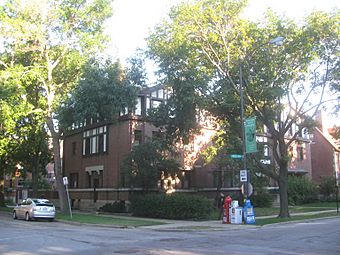Robert A. Millikan House facts for kids
|
Robert A. Millikan House
|
|
 |
|
| Location | 5605 S. Woodlawn Ave. Chicago, IL |
|---|---|
| Area | less than one acre |
| Built | 1907 |
| Architect | Tallmadge & Watson |
| Architectural style | Prairie School |
| NRHP reference No. | 76000699 |
Quick facts for kids Significant dates |
|
| Added to NRHP | May 11, 1976 |
| Designated NHL | May 11, 1976 |
The Robert A. Millikan House is a special old house located at 5605 South Woodlawn Avenue in the Hyde Park area of Chicago, Illinois. It was built around 1907. From about 1908 to 1921, this house was the home of a famous American physicist named Robert A. Millikan. During his time here, he did some of his most important work, which later won him a Nobel Prize. This three-story brick building was recognized as a National Historic Landmark on May 11, 1976, because of its historical importance.
Contents
About the Millikan House
The Robert A. Millikan House is in the Hyde Park neighborhood on Chicago's South Side. It's located northeast of the University of Chicago campus. You can find it at the southeast corner of South Woodlawn Avenue and East 56th Street. This house is one of three similar homes built around 1907. They were all designed by a Chicago architecture firm called Tallmadge & Watson.
What the House Looks Like
The house has three stories and is mostly made of brick. It has a wide, flat look, which is typical of the Prairie style of architecture. This style was popular in the early 1900s. The house has broad, gabled sections that stick out a little near the ends. The main entrance is a bit off-center and also sticks out. The entire third floor, and part of the second floor above the entrance, are decorated with Tudor-style half-timbering. This means it has wooden beams showing on the outside, with plaster or brick filling the spaces. The windows are placed in different sizes and spots, making the house look unique. Inside, the house is quite simple.
Robert Millikan's Amazing Discoveries
Robert Millikan was born in Illinois. He earned the very first Ph.D. in physics from Columbia University. He moved into this house around 1907 when he was a professor and researcher at the University of Chicago's physics department.
The Oil-Drop Experiment
While living in this house, Millikan set up and performed his famous oil-drop experiment. This experiment was very important because it helped him measure the electrical charge of an electron more accurately than ever before. Electrons are tiny particles that are part of every atom. Understanding their charge was a huge step forward in physics.
Confirming the Photoelectric Effect
Millikan also built special equipment to test something called the photoelectric effect. This effect was first suggested by Albert Einstein in 1905. The photoelectric effect explains how light can knock electrons out of a material. Millikan's experiments helped prove that Einstein's ideas were correct.
Winning the Nobel Prize
For his groundbreaking work on the electron's charge and the photoelectric effect, Robert Millikan was awarded the 1923 Nobel Prize in Physics. At that time, he was seen as one of the leading scientists in his field in America.
Later Years of the House
Robert Millikan moved out of this house in 1921. He took a new job at what is now the California Institute of Technology, a famous university in California. The Robert A. Millikan House is still a private home today.




